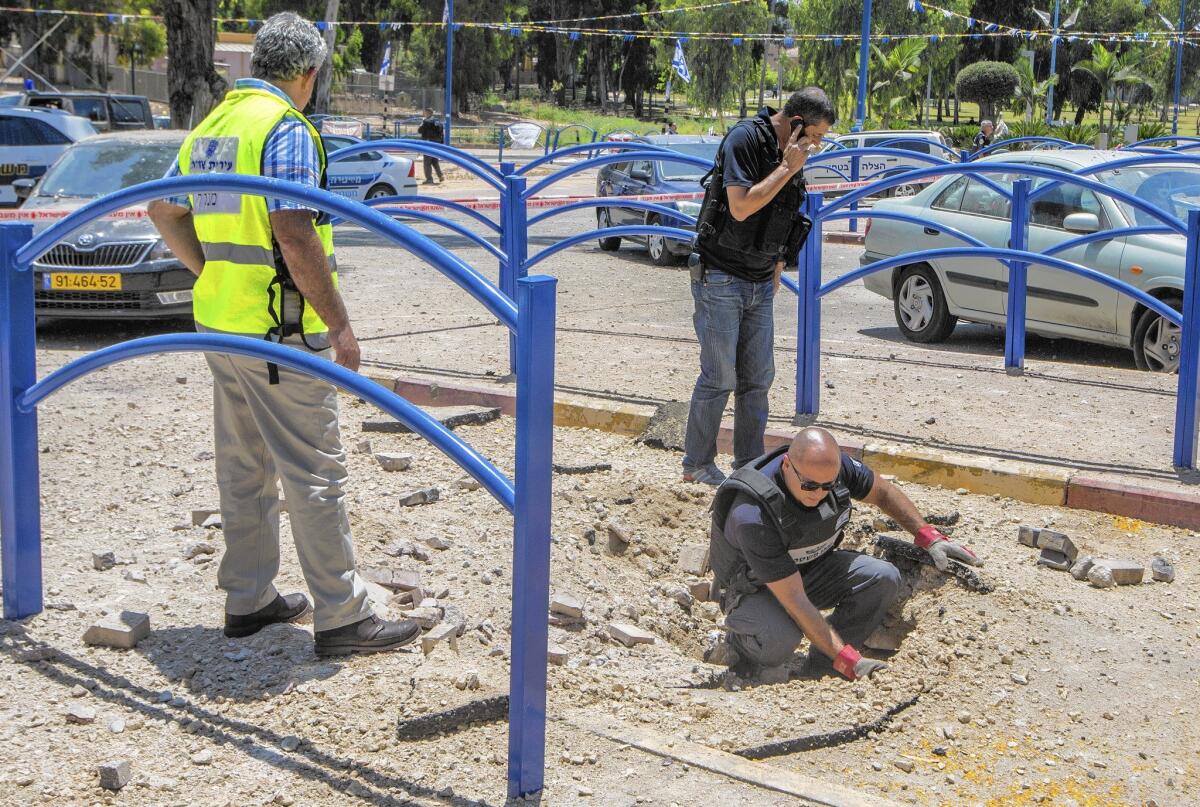Weary from war, many flee Israeli communities near Gaza

- Share via
Reporting from JERUSALEM — At the first hint the war in the Gaza Strip was heating up, Shirly Bashi packed her family, their toys and their clothes and left her home in Kibbutz Nir Am, close to the Gaza border.
“I knew this could be a long one,” she said.
That was five weeks ago. And she hasn’t been home since.
Nir Am is among a sprinkle of communities at the edge of the Negev desert, dotting the region with farm fields. The area is known year-round for fresh produce, wildflowers and an open landscape that attracts tourists looking for a breather from grinding city life.
In recent weeks, however, most traffic has been headed in the other direction as hundreds of residents took their families north for safety, half-emptying roughly a dozen communities. Most of those who stayed behind were essential workers.
After a month on the road, some came back during a cease-fire that began Tuesday and ended Friday. Bashi wasn’t among them.
First she stayed with relatives in the center of the country. She spent the next few weeks in a kibbutz hotel near Jerusalem, with 40 other families from Nir Am. A nearby community “adopted” the displaced families, cooked them nightly dinners, did their laundry, brought in social workers and invited their children to attend its preschools.
Out of harm’s way, Bashi and her neighbors were still jittery. “The slightest noise makes us jump,” she said.
In Tel Aviv, people have 90 seconds to take cover from incoming rockets, potentially lethal but infrequent. Along the border with Gaza, residents have 15 seconds at most, and the area is targeted much more frequently.
Almost 14 years since the first projectiles flew over the frontier, residents have emergency routines down to an art. But they’ve also had enough.
After years of matter-of-factly coping with rockets, many residents were unnerved by the new threat of cross-border infiltration tunnels dug by Palestinian militants. News of armed fighters popping out of holes in the ground within walking distance of residents’ homes sent more families packing.
Some made arrangements to stay with relatives and friends; others organized group evacuations to keep the community together. Whatever the arrangement, one question was on everyone’s mind: When would it be safe enough to return home?
Bashi, a 34-year-old landscaper, was in no hurry to go back. Her once-tranquil kibbutz now looks like an army base, she said.
“Honestly, I wonder about our future there,” she said. “The army is trying to calm us. They tell us the tunnel doesn’t lead into the kibbutz, that the opening is a kilometer away. What’s one kilometer? A few minutes.”
Ultimately, she said, people can accustom themselves to any threat.
“But that’s exactly the problem — I don’t want to get used to this,” she said. “And I am afraid of raising my children in fear.”
She is not alone. A poll this week indicated that 21% of the area’s residents are considering moving away.
A day into the latest cease-fire, the army told people living near Gaza they could return home, saying the area was far safer than before. Kibbutz Holit, not far from Bashi’s community, was still half-empty when the cease-fire expired and rocket fire from Gaza resumed Friday morning.
An hour before the truce ended, kibbutz leader Shimon Azoulay was already in the community’s situation room. The rocket barrage started moments after the cease-fire ended.
“I wasn’t surprised,” he said.
Sobelman is a special correspondent.
More to Read
Sign up for Essential California
The most important California stories and recommendations in your inbox every morning.
You may occasionally receive promotional content from the Los Angeles Times.










